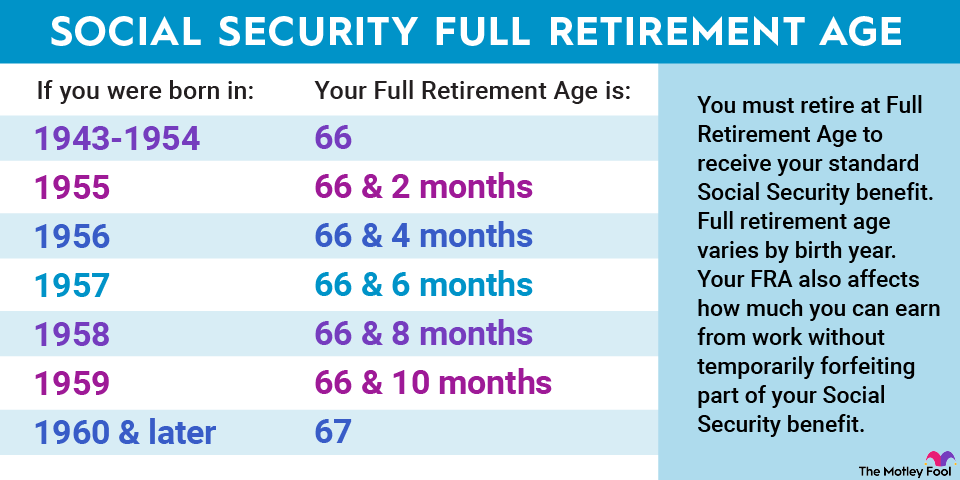When it comes to retirement finances, Social Security plays a huge role for millions of Americans. There are exceptions for some workers, but for the most part, tens of millions of people spend their careers paying Social Security taxes with the expectation of reaping the benefits on the back end with guaranteed retirement income.
Since Social Security is so important to many retirees’ financial well-being, it’s always a good idea to have an idea of what you can expect to receive, which depends a lot on when you claim benefits.
Due to changes like the annual Social Security cost-of-living-adjustment (COLA) and potential changes in your earnings, it may be hard to guess your exact benefit amount when you’re years out, but you can use average monthly benefits to begin planning your retirement finances.

How Social Security calculates your monthly benefit
Social Security calculates your monthly benefit using your average earnings during the 35 years when you earned the most money.
It adjusts your earnings for inflation (called “indexing”) to convert the amounts into today’s dollar value. Then, it divides the total number of months in those 35 years to get your average indexed monthly earnings (AIME). For those without 35 years’ worth of earnings, Social Security uses zeros for the missing years to calculate your average.
From there, Social Security applies a formula using bend points (which change annually) to determine your primary insurance amount (PIA) — the monthly benefit you’ll receive if you claim at your full retirement age. Here are full retirement ages based on your birth year:


The average Social Security benefits at ages 62, 67, and 70
Ages 62, 67, and 70 are key milestones in Social Security. Age 62 is the earliest you can claim benefits, 67 is most people’s full retirement age, and 70 is when monthly benefits stop increasing if you delay claiming them past your full retirement age.
Claiming Social Security at 62 would reduce your monthly PIA by 30%; delaying benefits until 70 would increase it by roughly 24% (assuming your full retirement age is 67). Since many people consider claiming Social Security at these three ages, I think it’s helpful to have an idea of what the average benefit looks like at those ages:
|
Age |
Average Monthly Benefit |
Men’s Average Monthly Benefit |
Women’s Average Monthly Benefit |
|---|---|---|---|
|
62 |
$1,275 |
$1,421 |
$1,141 |
|
67 |
$1,845 |
$2,055 |
$1,638 |
|
70 |
$1,963 |
$2,180 |
$1,744 |
Data source: Social Security Administration. Benefits rounded to the nearest whole dollar.
Again, these amounts will likely change because of COLAs, but it gives perspective on what many people can roughly expect to receive if they claim benefits at these ages.
Many people will find Social Security alone isn’t enough for retirement
The amount someone needs to have a fulfilling retirement varies widely. Factors like location, expenses, and retirement plans all influence how much someone would need in retirement.
Someone living in Southern California who plans to travel the world would likely need more saved than someone who wants to spend their time relaxing in the Outer Banks of North Carolina, for example. Regardless, many people will find that Social Security alone isn’t enough to fully cover their retirement expenses.
The goal should always be to have Social Security as supplemental retirement income. Of course, this isn’t feasible for many Americans, and millions use Social Security as their sole retirement income source. However, for those fortunate enough to have the means to take advantage of retirement accounts and other investments, it should absolutely be a priority.
By taking advantage of 401(k)s and IRAs, you put yourself in a position to lower your dependence on Social Security.
The $22,924 Social Security bonus most retirees completely overlook
If you’re like most Americans, you’re a few years (or more) behind on your retirement savings. But a handful of little-known “Social Security secrets” could help ensure a boost in your retirement income. For example: one easy trick could pay you as much as $22,924 more… each year! Once you learn how to maximize your Social Security benefits, we think you could retire confidently with the peace of mind we’re all after. Simply click here to discover how to learn more about these strategies.
View the “Social Security secrets” ›
The Motley Fool has a disclosure policy.
Here Are the Average Social Security Benefits at Ages 62, 67, and 70 was originally published by The Motley Fool
